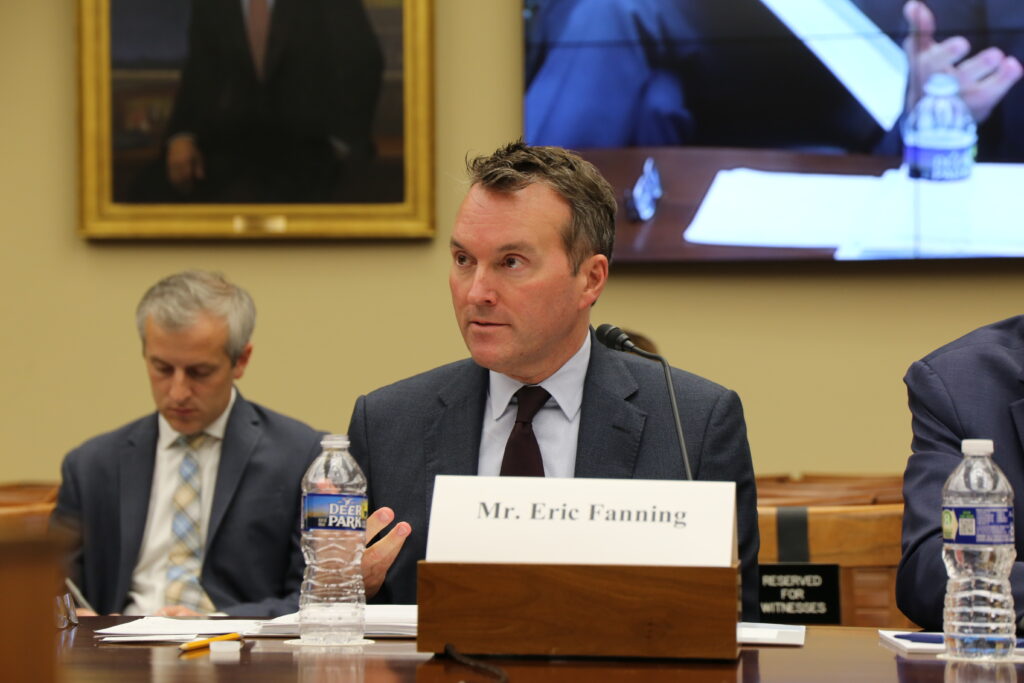Arlington, Va. – In case you missed it, yesterday, the Aerospace Industries Association (AIA) President and CEO Eric Fanning testified before the House Science, Space, and Technology’s Subcommittee on Investigations and Oversight hearing entitled “A Bar Too High: Concerns with CEQ’s Proposed Regulatory Hurdle for Federal Contracting.” The hearing focused on a proposed rule (FAR case 2021-015) requiring federal contractors to disclose greenhouse emissions throughout their complex supply chains and meet standards according to guidelines set by a foreign-run body.
Here are the six key takeaways from the hearing.

“…This rule opens the door for foreign influence over U.S. government procurement,” Fanning said. “SBTi…is led by foreign nationals and has no accountability to the U.S. government. The organization is designed to create transparency around greenhouse gas emissions, but has no transparency of its own,”
“The proposed rule taps into other international NGOs to solicit information regarding companies’ environmental impacts and targets. If a contractor does not provide this information or if SBTi does not approve their targets, then the contractor would be ruled ineligible for federal contracts. In other words, it gives an international body the authority to determine which American companies can and can’t do business with the U.S. government, including our military.
“It is an unnecessary and unacceptable risk for the U.S. government to divest this authority.”
“The difference in this rule from what’s taken place already is the addition of Scope 3 reporting requirements,” Fanning said. “For an industry like aerospace and defense that builds platforms, lasts for decades, and has a global supply chain and a global market, being able to get accurate information to aggregate into that report seems inexecutable.
“When you add in the national security component, because if you are talking about federal contractors and aerospace and defense, the Department of Defense, is the biggest customer. We are not even sure if they would offer that information, nor would we want them to for national security reasons. Part of the rule, if you read through all of it and carry it out, is that it is meant then to be transparent and shared publicly, so all our adversaries would have access to it as well.”
“Congress should be particularly concerned about the national security implications of the rule,” Fanning said. “If the Pentagon provides a total estimate of emissions, will the military then be bound to operate within those parameters, regardless of the threats we encounter? Will disclosing this information publicly provide sensitive information, including data about new-generation platforms and use scenarios, to our adversaries?”
“The issue for aerospace and defense is not knowing what the requirements will be; not understanding what this organization, SBTi, is thinking in terms of aerospace in defense, sector guidance, of how they are going to define what it is they want you to report and how to set these goals and achieve these goals. Most of the companies in aerospace and defense are already trying to do that now because of market demand. In fact, all of the major companies in aerospace and defense are defined by the rule, $50 million or more in government contracts, are disclosing some financial climate risk already,” Fanning said.
“For us, the bigger issue with this rule is Scope 3. It does sweep up the industrial base, the supply chain. The big defense companies have thousands of companies in their supply chain, so it would go far beyond the number of companies defined in the analysis of the rule and requires us to understand how the end-user is going to use the product, which is most of what falls into Scope 3 when you’re in an industry building things that are meant to last for 30 years.”
“Right now, the Pentagon and the defense community are concerned about the shrinking size of the defense industrial base. Companies, especially small and mid-sized companies, just cannot afford the costs of doing business with the U.S. government,” Fanning said. “This rule will become yet another market barrier for these smaller companies, which may turn to commercial work instead. A diverse defense industrial base is critical to our military meeting its growing mission set — and this rule would jeopardize that, even as a land war continues in Europe and the threat of conflict in the Indo-Pacific grows.”
“U.S. aviation manufacturers pledged to achieve net-zero carbon emissions by 2050. Today, manufacturers are building more efficient planes and more sustainable propulsion, they are also minimizing the impact of the manufacturing process and advancing the use of sustainable aviation fuels. Our companies are working daily to reduce their environmental footprint — not just because it’s the right thing to do, but because the market, and our customers, demand it,” Fanning said. “We strive to work closely with the federal government to achieve these goals. But the proposed FAR greenhouse gas emissions rule, while well-intended, is not executable for the American aerospace and defense industry.”
AIA supports appropriate disclosure of climate-related information, including greenhouse gas and climate-related financial risks, in accordance with the Executive Order on Climate-Related Financial Risk (EO 14030). In May 2023, AIA called on the Office of Management to block a proposal (FAR Case 2021-015) that would require certain federal contractors to disclose greenhouse gas (GHG) emissions throughout their complex supply chains. This request followed AIA’s formal comments filed in response to the proposed rule, submitted in February 2023. Learn more about AIA’s commitment to net-zero carbon emissions by 2050 here.
Click here to read Fanning’s full remarks.
###

